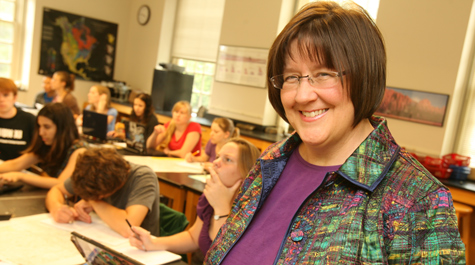Geologist Heather Macdonald wins a pair of national awards
Heather Macdonald, Chancellor Professor of Geology at William & Mary, has been recognized by her fellow scientists and educators for her contributions to the advancement of education in the earth sciences.
Macdonald is the 2014 recipient of the Excellence in Geophysical Education Award of the American Geophysical Union as well as the Robert Christman Award of the National Association of Geoscience Teachers.
“Dr. Macdonald has done no less than to lead the transformation of undergraduate geoscience education during the past two decades,” wrote Richelle M. Allen-King, a geology professor at the University of Buffalo, in nominating her colleague for the AGU’s Excellence in Geophysical Education Award.
The AGU award recognizes “a sustained commitment to excellence in geophysical education by a team, individual, or group." Macdonald notes that the first recipient of the Excellence in Geophysical Education award was Robert D. Ballard, the marine geoscientist who discovered the wreck of the Titanic.
Macdonald is the fifth recipient of the NAGT’s Robert Christman Distinguished Service Award. Her award letter cited numerous examples of service to the professional association of geoscience instructors, including holding a number of offices in the society, including president. The letter, from NAGT President Aida Awad, also notes Macdonald’s advocacy for women geoscience instructors.
“Your impact on NAGT has been profound, shaping not only our programming but also our approach to serving geoscience faculty. We appreciate your continued service and thank you for your tireless efforts on behalf of geoscience education and NAGT,” Awad wrote.
Nominees for both of the awards mention Macdonald’s involvement in national initiatives to support geoscience education. She was one of the creators of On the Cutting Edge, a national professional-development program that has received more than $8 million in funding from the National Science Foundation since 2002. She led “highly successful” workshops for early career geoscience faculty from across the country from 1999 to 2011 when she successfully passed the leadership of that workshop to Rachel Beane of Bowdoin College. She also was instrumental in the establishment of SAGE 2YC, a related initiative directed at the specific challenges faced by geoscience programs at two-year colleges.
“Her sustained mentorship, collaboration with, and encouragement of 2YC geoscience faculty in these workshops contributed to geoscience education reform at numerous 2YCs and produce a cadre of faculty who are now leaders in the 2YC geoscience community,” wrote Robert Blodgett, from Austin Community College.
The AGU and NAGT awards are only the most recent honors Macdonald has received. In addition to sharing awards for On the Cutting Edge, Macdonald was one of the three finalists for the Robert Foster Cherry Award for Great Teaching in 2011 and received the NAGT’s Neil Miner Award, for contributions to the stimulation of interest in the earth sciences, in 2009. Here at William & Mary, she received the Outstanding Faculty Award from the State Council of Higher Education in Virginia, one of 10 awarded across the Commonwealth in 2003. In 1990, she won William & Mary’s Thomas Jefferson Teaching Award, an honor given to teachers early in their career. A Fellow of the Geological Society of America, Macdonald also received the William & Mary Alumni Fellowship for Excellence in Teaching. She also received distinguished alumni awards from Carleton College and from the Department of Geosciences at the University of Wisconsin.
The American Geophysical Union is a professional, scientific organization representing more than 62,000 members in 144 countries, dedicated to advancing Earth and space sciences through its scholarly publications, conferences, and outreach programs. The National Association of Geoscience Teachers includes K-12 teachers and college and university faculty as well as educators working with the general public through outlets such as museums and science centers working to foster improvement in the teaching of the Earth sciences at all levels.















